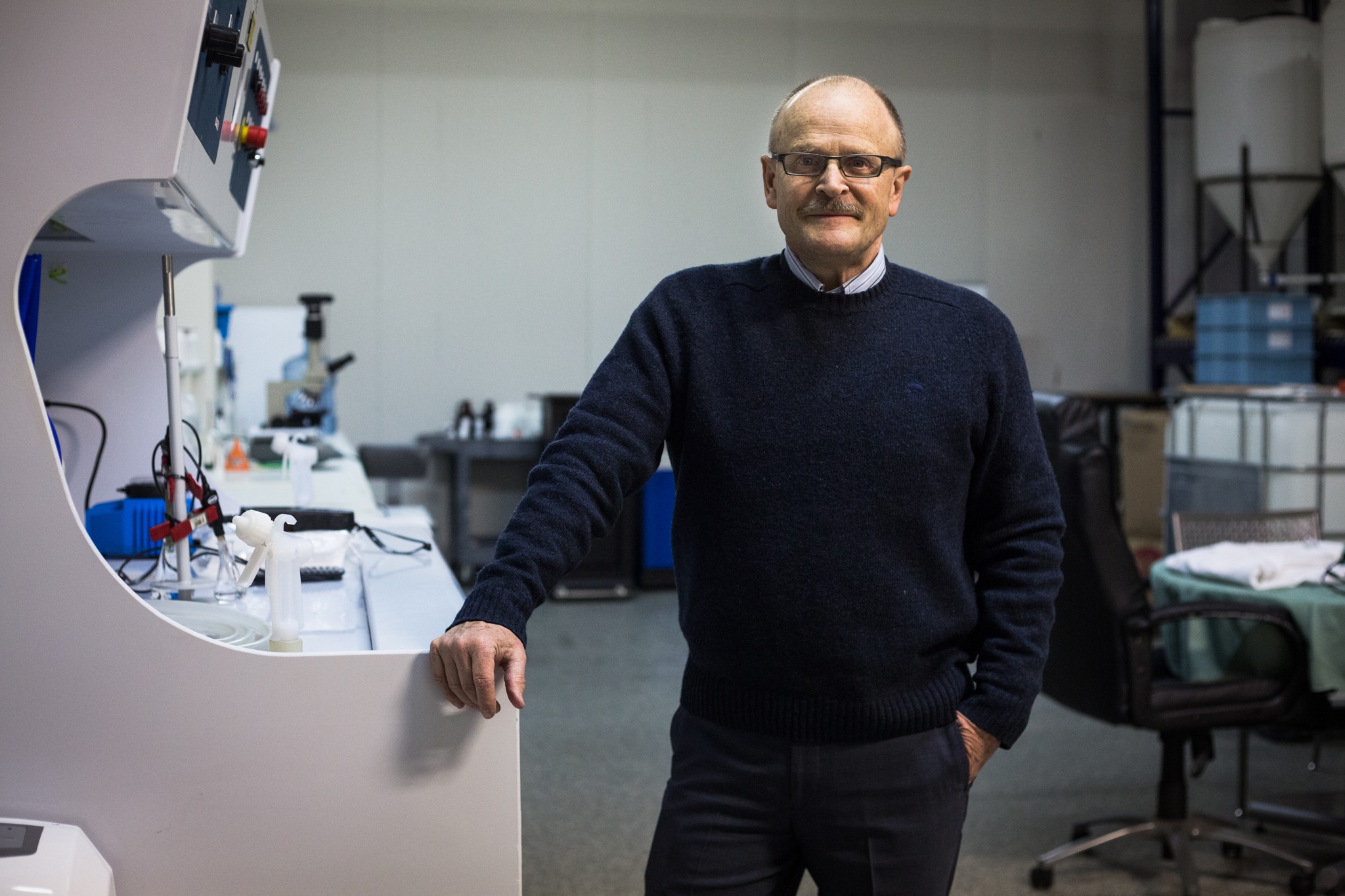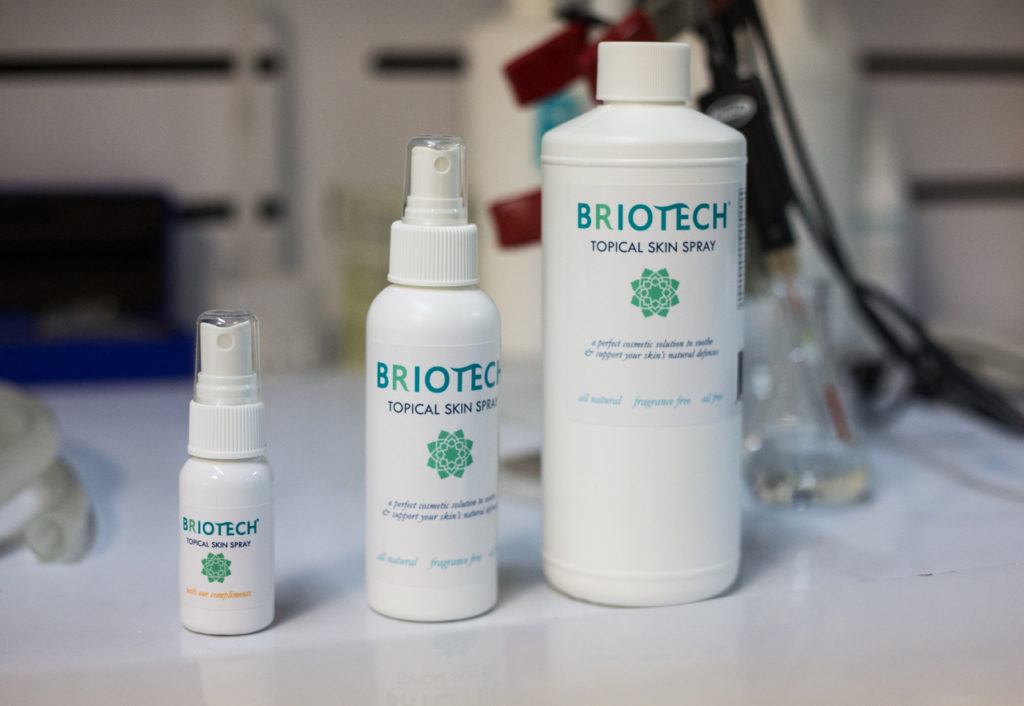By Patricia Guthrie
For The Herald Business Journal
Dan Terry is out to change the world. Or at least rid it of deadly germs, viruses and fungi that kill millions every year.
How?
With hypochlorous acid, known as HOCL, that mimics the human body’s response to wounds and invading microbes.
Medical science has long known about the wondrous ways of HOCL and inventors have long sought to duplicate its germ-fighting power with just the right mix of chemicals.
Replicating the body’s HOCL into a pure and stable solution as a low-cost liquid disinfectant has been the challenge. Mass producing HOCL and distributing it at an affordable price is the goal of Terry and his company, Briotech, Inc., based in Woodinville, just south of the Snohomish-King county line.
He envisions the spray could be used in health-care facilities, restaurants, cruise ships, water parks, any place where many people interact in a potential breeding ground for infectious diseases that are becoming increasingly resistant to antibiotics.
A mechanical engineer and inventor with a track record of patents over 30 years, Terry says he set out to “stop the spread of pathogens and literally change the discussion of health sanitation and healing of the world. There are no antibiotics left on the planet that haven’t failed.”
Briotech’s HOCL formula, called BrioHOCL, has yet to be scientifically tested on an array of the most prevalent, problematic pathogens that infect food, such as salmonella, listeria, e.coli O157:H7 or norovirus.
But in a recent federally funded study, the formula successfully inactivated one of the world’s deadliest infectious pathogens called prions. These misfolded proteins are the cause of bovine spongiform encephalopathy or mad-cow disease and the brain-wasting fatal disease in humans called Creutzfeldt-Jakob Disease (CJD).
A study published in medical journal PLOS Pathogens found Briotech’s HOCL formula “eliminated all detectable prion-seeding activity” in the brain tissue of humans known to have died of CJD, cattle infected with mad cow disease and other animals suffering from prion-caused disease.
“That it knocks out the infectivity completely that was in those brains, it was surprising,” said Byron Caughey, a senior investigator at the National Institute of Allergy and Infectious Diseases, a division of the National Institutes of Health, which led the study.
Current methods to knockout prions from surgical and laboratory equipment are so harsh, the equipment usually gets destroyed. Finding a safer, gentler method to disinfect prions in government research labs and in hospitals is a welcome discovery, Caughey said.
From acne to Ebola
After pouring $6 million into setting up the company warehouse and offices, traveling the world to learn from scientific experts and enduring chemical conundrums for years, Terry says Briotech is making inroads toward his goal of becoming an important public health tool.
BrioHOCL is already in use in 22 countries, from Ghana to Qatar, and it’s being considered for sanitation systems, health-care settings and other uses in 35 countries.
While company executives travel globally to establish partnerships with local governments, the product is also available online in much smaller quantities. It sells on Amazon in spray bottles as a “cosmeceutical created to protect and promote skincare wellness.” But it’s doing so quietly.
“We don’t advertise, we’re relying on word of mouth,” Terry says.
The 4-ounce bottle at $14.95, and 16 ounce for $39.95, additionally are plugged as “an all-natural and potent signaling solution that mimics the essence of human healing.” On the company website, and in Amazon product testimonials, dozens of customers state that the spray cleared their acne, helped heal wounds faster and calmed skin irritations.
BrioHOCL would have helped tremendously during the Ebola epidemic in West Africa, said Dr. Eric Rasmussen, a Navy physician and Briotech’s chief medical officer. With 25 years of experience in disaster and response medicine, Rasmussen leads Briotech’s emergency response team.
The company has donated its product to relief aid clinics in a dozen countries, including Nepal, Haiti, Peru, and India as well as to local charities. It’s also been used as a misting fogger at an apple warehouse in Yakima.
“This is a breakthrough in health sanitation and cleaning,” Rasmussen says. “It’s a fast, effective benign methodology to kill these public pathogens. Now we have to get people to adopt it.”
Terry calls his product an example of “disrupter technology,” one that creates a new market and displaces established practices. For that reason, large health-care organizations, food manufacturers and other systems in the U.S. needing to meet sanitation code may be hesitant to switch disinfectant practices.
One system it has cracked is the funeral industry. Briotech is partnering with Dodge Company, an international supplier to funeral homes, in supplying its BrioHOCL sanitizing spray.
Funeral homes have been known to refuse bodies suspected of being exposed to CJD, fearing contamination and spread from deadly prions.
Safe yet effective
Terry co-founded Briotech with his wife and chief administrative officer, Cynthia Varela. They previously ran Danterry Inc., which specialized in product development of thermal and alternative energy. (Terry’s most famous invention: Jane Fonda’s first treadmill sold during her aerobic exercise era of the 1980s.)
The name of the company seems a play on words for biotech but Terry stresses he named it Briotech because the word “brio” means strength, spirit, life, action, passion and energy. Its website states: True to our name, we are passionate about our formulation and we are energized by our committment to make a difference in people’s lives and the world.”
Other companies have been able to create artificial HOCL, but only in small quantities and usually at high costs. These companies target specific small markets, such as wound cleaning, infections of the eye and agricultural decontamination.
Briotech’s specially formulated HOCL is licensed as proprietary and the Woodinville warehouse where the product is manufactured and packaged is FDA approved, Terry said. One advantage of the product is it’s safer to handle than other sanitizing formulas, including bleach, which irritates skins and ruins clothing when used regularly.
Even though the recent federal study found BrioHOCL can inactivate one of the toughest pathogens on earth — prions — the spray is “perfectly safe,” says Terry who resembles a shorter version of another unusual chemist, Breaking Bad’s Walter White.
“See,” he says, aiming a sample size bottle toward his face, “I can spray it my eyes. Doesn’t hurt.” (Terry has also been known to stand in buckets of the stuff to prove it doesn’t sting, irritate or burn.)
People protecting themselves
If Terry’s global mission goes according to plan, BrioHOCL will help make water systems clean worldwide, stop the spread of deadly infections in hospitals, eliminate the spread of food poisoning in agricultural settings, food plants and commercial kitchens and help curb cholera and other diseases during natural disasters.
A miniature water treatment plant built into in a 20-foot shipping container sits in the back of the company’s Woodinville warehouse.
Giving a tour, Terry comments, “I wanted to be able to drop it into a valley in Sri Lanka so a 15-year-old kid with no training can drop a hose and be able to produce 60,000 liters a day of ultra pure water.”
His plan includes turning over the manufacturing of the liquid formula to local governments or companies to provide jobs, along with better health.
“Our goal is to help people protect themselves,” Terry says. “I wanted to get a solution into the hands of the people who need it. The proof will be the lack of problems.”
It is unknown whether BrioHOCL will be the long-waited solution to accessible, clean water in remote villages or make a dent in global rates of cholera, hepatitis, typhoid and other persistent infectious diseases. But Terry, 60, is determined to try.
“I’ve made a lot of inventions but they didn’t fulfill me,” he says. “This justifies the oxygen and hydrogen I take up in the world.”
A mad cow killer
The company is careful not to make any product claims. On its website, consumers are directed to a dozen scientific studies published over the years on the benefits of HOCL
It also spotlights the recent NIH study.
Prions are known to be one of toughest pathogens to kill.
They withstand extremely high temperatures (1,100 degrees F) and chemical decontamination efforts against prions are dangerous to people and equipment.
The study substituted stainless steel wire as a surrogate for expensive surgical instruments, said Caughey, the NIH scientist. BrioHOCL effectively knocked out prions and it didn’t irritate surfaces or skin.
“It seems like you can practically bathe in it,” he said. “I think it will have an extraordinary important application in the world.”
Joel Watts, an assistant professor at the University of Toronto’s Tanz Centre for Research in Neurodegenerative Diseases, called the findings groundbreaking, but with a caveat.
“I would caution against assuming that it will be effective against every single pathogen out there,” said Watts, who was not involved in the NIH study. “Nonetheless, all the evidence points to BrioHOCL being the best prion disinfectant discovered to date, which is itself a remarkable achievement.”
So is there anything it can’t do?
Rising from this chair, the inventor of the germ-buster-in-a-bottle answered.
“Well,” Terry said, patting his head. “I’m still short and I’m still bald.”
Talk to us
> Give us your news tips.
> Send us a letter to the editor.
> More Herald contact information.


























